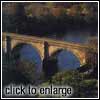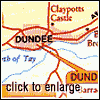|
Dunkeld

Dunkeld is another focal point in the historic and scenic
fabric of Perthshire.
Historically, it was the centre of Scottish ecclesiastical
life in the ninth century. The first monks establishing themselves here in AD729
were St Columba's driven from Iona by Viking warriors. The ancient Cathedral, set
in spacious parkland leading down to the River Tay, was re-founded in the early twelfth
century.
Today, the choir has been restored and is used as
the parish church. The great north-west tower and the nave date from the fifteenth
century and have been under restoration for several years. At the back of the Cathedral
you will find a huge larch tree known as the 'parent larch'. It may be the first
grown in Scotland, planted in 1737 and has, no doubt, many off-spring decorating
forests, parks and gardens around the country.
Dunkeld Little Houses date from the rebuilding of
the town following the Battle of Dunkeld in 1689 when the Jacobite army was trapped
in their lodgings and the Cameronians set the houses alight. Only the cathedral and
three houses survived. The National Trust for Scotland own and restored most of the
early eighteenth-century houses in Cathedral Street and the High Street. The Ell
Shop, also Trust owned, is named after a hand weaver's measure that was embedded
in the wall. Across the square from the Ell Shop is the military Museum of the Scottish
Horse Regiment.
 Two miles (3km) north-east of Dunkeld is the Loch of Lowes.
a nature reserve where a family of Ospreys have returned to the nest for several
years. These birds, and many other species that frequent the loch, can been seen
from a specially constructed hide. There is also a wildlife exhibition at the Visitor
Centre. Two miles (3km) north-east of Dunkeld is the Loch of Lowes.
a nature reserve where a family of Ospreys have returned to the nest for several
years. These birds, and many other species that frequent the loch, can been seen
from a specially constructed hide. There is also a wildlife exhibition at the Visitor
Centre.
The adjoining village of Birnam lies just across the
bridge from Dunkeld. Birnam is probably best known for its Shakespearean associations
where, in the play Macbeth, the moving of Birnam Wood to Dunsinane, 12 miles (19km)
to the south-east, heralded the death of Macbeth.
Between Dunkeld and Perth is the Perthshire Visitor
Centre, just off the A9 and incorporating a multi-media exhibition that contrasts
Shakespeare's character of Macbeth with the real eleventh-century Scottish King.
|


